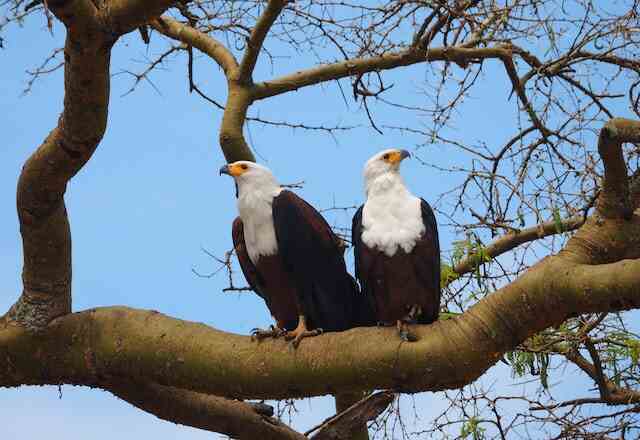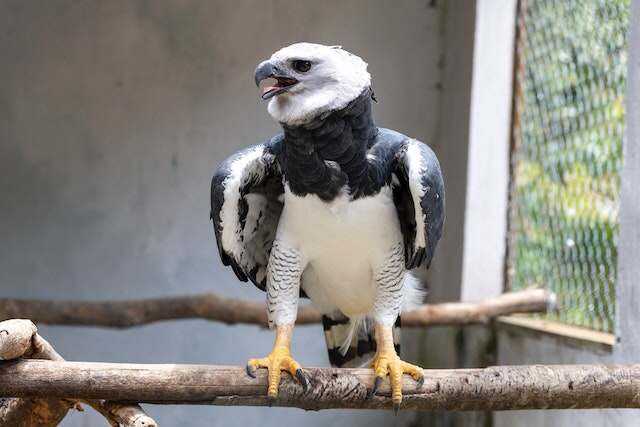Do Eagles Eat Snakes? This article delves into the intriguing relationship between eagles and snakes, shedding light on the preferred snake species that eagles consume and the adaptations they possess for capturing these elusive creatures.
Explore the unique feeding behaviors exhibited by eagles and discover the conservation implications of protecting both eagles and their snake prey.
Uncover lesser-known facts about eagles and snakes while answering the question: Do eagles eat snakes? Join us as we unravel the captivating dynamics between these majestic birds of prey and their slithering prey in the natural world.
Table of Contents
- 1 Key Takeaways
- 2 The Diet of Eagles: Exploring their Varied Food Choices
- 3 Hunting Techniques: How Eagles Capture their Prey
- 4 Do Eagles Eat Snakes
- 5 Snakes as a Food Source: Understanding their Importance in Eagle’s Diet
- 6 Preferred Snake Species: Which Snakes are Eagles Most Likely to Eat?
- 7 Adaptations for Snake Consumption: How Eagles Overcome the Challenges
- 8 Role of Snakes in Eagle’s Ecosystem: Examining the Ecological Impact
- 9 Unique Feeding Behaviors: Observing Eagles’ Interaction with Snakes
- 10 Eagle-Snake Interactions in the Wild: Real-life Examples and Behaviors
- 11 Conservation Implications: Protecting Eagles and their Snake Prey
- 12 Fascinating Facts: Lesser-known Information about Eagles and Snakes
- 13 Frequently Asked Questions
- 13.1 How do eagles locate snakes in their environment?
- 13.2 Are there any specific hunting techniques that eagles use to catch snakes?
- 13.3 Do eagles have any adaptations specifically for consuming snakes?
- 13.4 What is the ecological impact of eagles consuming snakes?
- 13.5 Can you provide any real-life examples of eagle-snake interactions in the wild?
- 14 Conclusion
- 15 Author
Key Takeaways
- Eagles have a diverse diet that includes snakes.
- Snakes are a vital component of the eagle’s diet, providing protein, vitamins, and minerals.
- Eagles have specialized beaks, powerful talons, and keen eyesight to overcome the challenges of consuming snakes.
- The predator-prey dynamics between eagles and snakes help maintain a delicate equilibrium in the ecosystem.

The Diet of Eagles: Exploring their Varied Food Choices
The dietary preferences of eagles encompass a diverse range of food sources, including but not limited to snakes. Eagles are opportunistic predators and their feeding habits reflect this adaptability.
While snakes are indeed a part of their diet, they also consume other animals such as fish, small mammals, birds, and carrion.
Eagles have a specialized digestive system that allows them to efficiently process and extract nutrients from their prey.
After capturing a snake, the eagle’s powerful beak and talons enable it to tear apart the prey and consume it.
The snake digestion process involves the breakdown of proteins, fats, and carbohydrates, which are then absorbed and assimilated by the eagle’s body.
Understanding the eagle’s diverse diet and snake digestion process provides insight into their ability to thrive in a variety of environments.
Transitioning to the next section, we will now explore the hunting techniques employed by eagles to capture their prey.
Hunting Techniques: How Eagles Capture their Prey
During their hunting expeditions, eagles employ various techniques to seize their prey, including the capture of serpentine creatures. To successfully overcome obstacles and secure their meal, eagles utilize the following hunting strategies:
- Aerial Ambush: Eagles often perch on high vantage points and wait for potential prey to pass by. With their keen eyesight, they swiftly swoop down, surprising their prey and grasping it with their sharp talons.
- Dive Bombing: Some species of eagles, such as the majestic Bald Eagle, employ a strategy known as dive-bombing. They soar high in the sky and then rapidly descend with incredible speed, using their powerful wings and talons to snatch their prey from the water’s surface.
- Cooperative Hunting: Certain eagle species, such as the African Fish Eagle, engage in cooperative hunting. They work together, strategically encircling their prey and attacking simultaneously, increasing their chances of a successful capture.
Understanding these hunting techniques provides insight into the eagles’ unique adaptations and the role they play in securing their food source.
Transitioning into the subsequent section, we will explore the importance of snakes in the eagle’s diet.
Do Eagles Eat Snakes
Yes, eagles do eat snakes. Some eagle species have a preference for certain snake types, such as garter snakes, rattlesnakes, and tree boas.
Eagles employ various methods of attack, including aerial swoops, diving strikes, and powerful talon grips.
Snakes serve as a significant food source for eagles, highlighting their adaptability as apex predators in the natural world.
Snakes as a Food Source: Understanding their Importance in Eagle’s Diet
Snakes, being a vital component of the eagle’s diet, contribute significantly to their nutritional needs. These reptiles are not only a rich source of protein, but also provide essential vitamins and minerals required for the eagle’s overall health.
To better understand the importance of snakes in an eagle’s diet, let us delve into their hunting techniques and the eagle’s digestive system.
Eagle’s sharp eyesight and agility enable them to locate and capture snakes effectively.
Once caught, the eagle’s digestive system efficiently breaks down the snake’s tough skin and scales, extracting nutrients through a process of enzymatic digestion.
This ensures that the eagle receives maximum benefit from its prey. Transitioning into the subsequent section, let us now explore the preferred snake species that eagles are most likely to consume.
Preferred Snake Species: Which Snakes are Eagles Most Likely to Eat?
Reptiles from the snake family play a crucial role in an eagle’s diet, and understanding the specific species that eagles are more likely to consume can provide insights into their hunting patterns and preferences.
Eagles are known to interact with a variety of snake species, but certain snakes are more preferred than others.
Studies have shown that eagles tend to favor larger snake species such as rattlesnakes and water snakes, which provide a substantial amount of energy and nutrients.
This preference may be influenced by factors such as the availability and abundance of these particular snake species in the eagle’s habitat.
By focusing on these preferred snake species, eagles are able to optimize their foraging efficiency and maximize their overall energy intake.
| Eagle Species | Snake Types Consumed | Methods of Attack |
|---|---|---|
| Bald Eagle | Garter snakes, water snakes | Aerial swoops, talon strikes |
| Golden Eagle | Rattlesnakes, bullsnakes | Diving attacks, powerful talon grip |
| Harpy Eagle | Tree boas, anacondas | Ambush strikes, talon immobilization |
| African Fish Eagle | Water moccasins, cobras | Diving grabs, beak strikes |
| Crested Serpent Eagle | Vine snakes, keelbacks | Stealthy approaches, talon puncture |
| Martial Eagle | Spitting cobras, black mambas | Swift descents, lethal talon grip |
| Philippine Eagle | Pit vipers, rat snakes | Coordinated strikes, talon restraint |
| Steller’s Sea Eagle | Sea snakes, eels | Water plunges, powerful beak grasp |
| White-bellied Sea Eagle | Sea kraits, sea snakes | Diving catches, beak immobilization |
Please note that the table represents general tendencies and may vary depending on specific habitats and individual eagle behavior.
Transitioning into the subsequent section, eagles have developed remarkable adaptations for consuming snakes, allowing them to overcome the challenges associated with capturing and consuming these elusive and often venomous prey.

Adaptations for Snake Consumption: How Eagles Overcome the Challenges
Adapting to the challenges of capturing and consuming their elusive and often venomous prey, eagles have developed remarkable adaptations that allow them to efficiently consume snakes.
These adaptations include specialized beaks, powerful talons, and keen eyesight. The beak of an eagle is sharp and hooked, enabling it to pierce and hold onto the snake while the talons immobilize it.
Additionally, eagles have strong neck muscles that allow them to twist their heads in various directions, facilitating the swallowing of snakes.
Their exceptional eyesight enables them to locate and track snakes from great distances, ensuring a successful hunt.
To evoke an emotional response in the audience, a table is provided below that showcases the awe-inspiring abilities of eagles in overcoming the challenges of snake consumption:
| Adaptation | Description | Importance |
|---|---|---|
| Specialized Beak | Sharp and hooked to hold onto snake | Allows for secure grip |
| Powerful Talons | Immobilizes the snake | Prevents escape |
| Keen Eyesight | Enables locating and tracking snakes from afar | Ensures successful hunt |
As eagles effectively overcome the challenges of consuming snakes, it is essential to examine the ecological impact of these reptiles in the eagle’s ecosystem.
Role of Snakes in Eagle’s Ecosystem: Examining the Ecological Impact
After exploring the adaptations that allow eagles to consume snakes, it is crucial to examine the role of snakes in the eagles’ ecosystem and the ecological impact they have.
As predators, snakes help to regulate the abundance of their prey, which ultimately affects the overall biodiversity and stability of the ecosystem.
The predator-prey dynamics between eagles and snakes ensure that neither population becomes too dominant, maintaining a delicate equilibrium.
Additionally, the consumption of snakes by eagles helps to prevent the overpopulation of snakes, which could have adverse effects on other organisms in the ecosystem.
Understanding the ecological interactions between eagles and snakes is crucial for comprehending the intricate web of relationships that contribute to the functioning of ecosystems.
This understanding sets the stage for exploring the unique feeding behaviors and interactions between eagles and snakes.
Unique Feeding Behaviors: Observing Eagles’ Interaction with Snakes
Observing the unique feeding behaviors of eagles provides insight into the intricate interactions between these majestic birds and their slithery prey. Eagles exhibit a range of strategies when hunting and consuming snakes, showcasing their adaptability and resourcefulness.
These behaviors include:
- Swooping down from great heights to catch a snake mid-air
- Using their sharp talons to immobilize the prey
- Swiftly tearing it apart with their powerful beaks
Additionally, eagles have been observed to engage in aerial battles with snakes, where they engage in mid-air combat, maneuvering to gain the upper hand.
This display of agility and precision is truly remarkable, highlighting the eagles’ mastery of their environment.
Studying these unique feeding behaviors not only provides a deeper understanding of the ecological dynamics between eagles and snakes but also offers a glimpse into the awe-inspiring capabilities of these magnificent birds.
Transitioning into the subsequent section about ‘eagle-snake interactions in the wild: real-life examples and behaviors,’ we delve further into the fascinating world of these fascinating creatures.

Eagle-Snake Interactions in the Wild: Real-life Examples and Behaviors
Eagles and snakes have a fascinating relationship in the wild, with the former often preying on the latter. To better understand this dynamic, it is important to examine the eagle’s hunting strategies and the snake’s defense mechanisms.
Eagles employ various techniques when hunting snakes, such as aerial attacks and ground-based pursuits. They rely on their excellent vision and agility to quickly seize their prey.
On the other hand, snakes have evolved several defense mechanisms to protect themselves from eagle predation. These include camouflage, venomous bites, and rapid movements to escape.
The interaction between eagles and snakes in the wild showcases the intricate balance between predator and prey.
Understanding these behaviors and strategies is crucial for conservation efforts aimed at protecting both eagles and their snake prey.
By conserving their habitats and ensuring the availability of suitable prey, we can contribute to the preservation of these remarkable species.
Transitioning seamlessly into the subsequent section, conservation implications become apparent in safeguarding the delicate ecological relationship between eagles and snakes.
Conservation Implications: Protecting Eagles and their Snake Prey
Conservation efforts aimed at protecting the delicate ecological relationship between eagles and their snake prey entail preserving their habitats and ensuring an abundance of suitable prey, thereby contributing to the preservation of these remarkable species.
To achieve this, the following steps can be taken:
- Protecting snake populations: Implementing measures to conserve snake populations will help maintain a stable food source for eagles. This can include safeguarding their habitats, reducing habitat destruction, and implementing conservation programs specifically tailored for snake species.
- Impact on the food chain: Eagles play a crucial role in the food chain by regulating snake populations. By preying on snakes, they help control their numbers and prevent overpopulation, which can have cascading effects on the ecosystem. Protecting eagles ensures the balance of the food chain and the overall health of the ecosystem.
- Promoting awareness and education: Educating the public about the importance of eagles and their snake prey can foster a sense of responsibility and encourage conservation efforts. By raising awareness, people can actively participate in protecting these species and their habitats.
Conservation efforts not only safeguard the relationship between eagles and snakes, but also contribute to the preservation of biodiversity.
Transitioning to the subsequent section, let’s explore some fascinating facts about eagles and snakes.
Fascinating Facts: Lesser-known Information about Eagles and Snakes
Unbeknownst to many, eagles and snakes possess fascinating characteristics and engage in intriguing behaviors that shed light on their intricate relationship.
While it is commonly known that eagles are opportunistic predators and snakes are a potential prey item, there are lesser-known interactions between these two species that contribute to eagle conservation.
Eagles have been observed using snakes as a food source, particularly when other prey is scarce. This highlights the adaptability of eagles in utilizing different food sources to survive.
Furthermore, snakes play an important role in eagle conservation by providing a natural control on rodent populations, which can have negative impacts on the eagle’s habitat.
This highlights the complex web of interactions within ecosystems and emphasizes the importance of preserving diverse habitats for the conservation of both eagles and their snake prey.

Frequently Asked Questions
How do eagles locate snakes in their environment?
Eagles utilize various visual and auditory cues to detect snakes in their environment. They have exceptional eyesight, enabling them to spot the movement of snakes from a considerable distance, while their acute hearing allows them to detect the faint sounds produced by slithering snakes.
Are there any specific hunting techniques that eagles use to catch snakes?
Eagles employ various hunting strategies to catch snakes, such as aerial attacks and surprise pounces. They rely on their exceptional visual acuity and sharp talons to detect and capture their elusive prey, employing a combination of stealth, agility, and precision.
Do eagles have any adaptations specifically for consuming snakes?
Eagles have developed adaptations for consuming snakes. They possess excellent visual acuity, allowing them to detect snakes from great distances. Additionally, their sharp talons and strong beaks enable them to efficiently capture and consume snakes.
What is the ecological impact of eagles consuming snakes?
The ecological consequences of eagles consuming snakes include influencing food chain dynamics. Eagles act as top predators, regulating snake populations and maintaining ecosystem balance. This interaction contributes to species diversity and the overall functioning of the ecosystem.
Can you provide any real-life examples of eagle-snake interactions in the wild?
Real-life examples of eagle-snake interactions in the wild include instances where eagles, such as the African fish eagle and the bald eagle, have been observed hunting and capturing snakes as a part of their diet.
Conclusion
In conclusion, the diet of eagles encompasses a diverse range of food choices, and snakes play a crucial role in their sustenance.
Through their unique hunting techniques and adaptations, eagles are able to overcome the challenges posed by consuming snakes.
These interactions between eagles and snakes in the wild offer fascinating insights into the natural world.
Understanding and conserving these interactions is of utmost importance to protect both eagles and their snake prey.
Delving deeper into the intricacies of eagle-snake interactions reveals a captivating and complex relationship worth exploring further.


